#black women matter
Explore tagged Tumblr posts
Text
I could be overthinking, but can we take a look at the "type" of men who pursued Megan Thee Stallion during such a traumatic time.
Tory Lanez, Da Baby, Pardi, Trey Songz
Notice how differently all of them reacted to her before, during, and after. All of them, IMO, took advantage of her grief. They "picked" Megan not because she was strong and beautiful but because of what she was in that moment- vulnerable and lost.
A rising star who was grieving loss after loss. A woman who at a pivotal moment coped through alcohol and, imo, relationships. I think they all took notice of that in different ways.
Tory and Da Baby both have a history of being abusive in some way, whether physically or verbally. Pardi showed his true feelings after their breakup. Trey has a history as well and showed his in the video where he tried to make her keep drinking when she was refusing and already intoxicated. None of their reactions are indicative of men who love, admire, or care for someone, not platonically or romantically.
*This is merely my opinion as a chronic overthinker, but... the patterns are there.
**I hope this makes sense.


#megan thee stallion#meg thee stallion#thee stallion#in her words#protect black women#protect black girls#protect women#black women deserve better#black women matter#we love you megan
337 notes
·
View notes
Text

Prayers to the family
262 notes
·
View notes
Text
#natural hairstyles#natural hair care#naturalhair#black women#afro#black woman#melanin#natural hair#beauty standards#beautiful black women#black lives matter#black lives are beautiful#blacklivesmatter#black women magic#black woman beauty#black women matter#blacklove
125 notes
·
View notes
Text
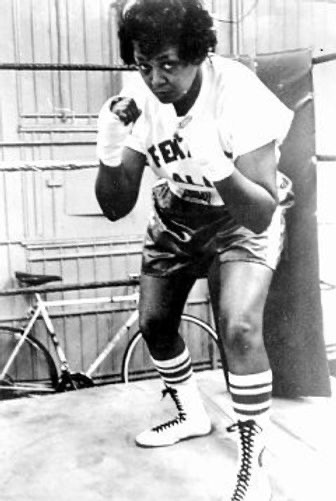
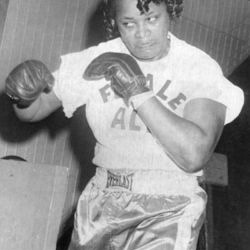
Jackie Tonawanda was known in her prime as 'The Female Ali'. She was an incredible woman who boxed for years before women were allowed to fight in sanctioned bouts.
She was one of the great pioneers of women's boxing, being one of the first women awarded a boxing licence in New York.
She lost her only professional fight but holds an impressive record from her underground bouts. She was even named the No. 1 light heavyweight by Boxing Illustrated in 1979 and 1980.
Due to the majority of her fights being unsanctioned as women were not allowed to prize fight her record is hard to determine.
Sources claim it anywhere from 23-0 to 36-0. Despite this uncertainty Tonwanada's achievements go far beyond her boxing record. She was the first woman to box in Madison Square Garden in 1975. Her opponent was kickboxer Larry Rodania whom she knocked out in the second round with a strike that broke his jaw. A man fighting a woman in such a public venue was unheard of, however it pushed female fighters into the spotlight.
Tonawanda faced sexism head on and set out to prove that women were more than capable as pugilists. She sued the state for discrimination and the state supreme court ruled in her favour, urging her to sue once again to have the laws preventing women from boxing to be revoked. Tonwanda did not pursue further legal action, in the coming years she would continue to fight in underground bouts and in 1976 she was invited to attend a training camp for Muhammad Ali.
Her movement to recognise women's boxing as legitimate was taken further by fellow boxer Cathy Davis in 1978 which lead to Davis, Tonawanda and Marian Trimiar to be the first women to receive boxing licenses in the state of New York. After gaining her licence and being allowed to fight professionally Tonawanda was much older than her contemporary opponents.
She fought one professional bout against Diane Clark and lost in the 6th round by split decision, making her professional record 0-1. In 1986 she was injured in a car accident which forced her to officially retire, ending her professional career.
•••
Jackie Tonawanda era conocida en su mejor momento como "La mujer Ali". Era una mujer increíble que boxeó durante años antes de que a las mujeres se les permitiera pelear en combates autorizados.
Fue una de las grandes pioneras del boxeo femenino, siendo una de las primeras mujeres en obtener una licencia de boxeo en Nueva York.
Perdió su única pelea profesional, pero tiene un récord impresionante de sus peleas clandestinas. Incluso fue nombrada semipesado número uno por Boxing Illustrated en 1979 y 1980.
Debido a que la mayoría de sus peleas no fueron autorizadas ya que a las mujeres no se les permitía pelear, su récord es difícil de determinar.
Las fuentes afirman que está entre 23-0 y 36-0. A pesar de esta incertidumbre, los logros de Tonwanada van mucho más allá de su récord en el boxeo. Fue la primera mujer en boxear en el Madison Square Garden en 1975. Su oponente fue el kickboxer Larry Rodania, a quien noqueó en el segundo asalto con un golpe que le rompió la mandíbula. Que un hombre peleara con una mujer en un lugar tan público era algo inaudito, sin embargo, puso a las luchadoras en el centro de atención.
Tonawanda enfrentó el sexismo de frente y se propuso demostrar que las mujeres eran más que capaces como pugilistas. Ella demandó al estado por discriminación y la corte suprema del estado falló a su favor, instándola a demandar una vez más para que se revoquen las leyes que impiden a las mujeres boxear. Tonwanda no emprendió más acciones legales, en los años siguientes continuaría peleando en combates clandestinos y en 1976 fue invitada a asistir a un campo de entrenamiento para Muhammad Ali.
Su movimiento para reconocer el boxeo femenino como legítimo fue llevado más allá por su compañera boxeadora Cathy Davis en 1978, lo que llevó a Davis, Tonawanda y Marian Trimiar a ser las primeras mujeres en recibir licencias de boxeo en el estado de Nueva York. Después de obtener su licencia y poder pelear profesionalmente, Tonawanda era mucho mayor que sus oponentes contemporáneos.
Peleó en una pelea profesional contra Diane Clark y perdió en el sexto asalto por decisión dividida, lo que hizo que su récord profesional fuera de 0-1. En 1986 sufrió un accidente automovilístico que la obligó a retirarse oficialmente, poniendo fin a su carrera profesional.
#boxer#boxing girl#boxing#sports#blackgirlmagic#history#blackhistory#blackhistorymonth#blackpeoplematter#black history matters#black history is everybody's history#historyfacts#black history is world history#black history is american history#black history#black history month#blacklivesalwaysmatter#blacklivesmatter#historia#black women matter#women in sports#knowyourhistory#culture#blackhistoryyear#lasvidasnegrasimportan#cultura#boxeadora#boxeo#heritage#womeninspiration
44 notes
·
View notes
Text
If you ever tell a black woman 'your personality matters more than your looks' instead of calling her pretty,i think you should kill yourself
#ex-best friend tag#misogynoir#blackness#antiblackness#masculinization of black women tw#black women matter#white feminism#intersectional feminism#white woman fragility#💌#summerposting
50 notes
·
View notes
Text
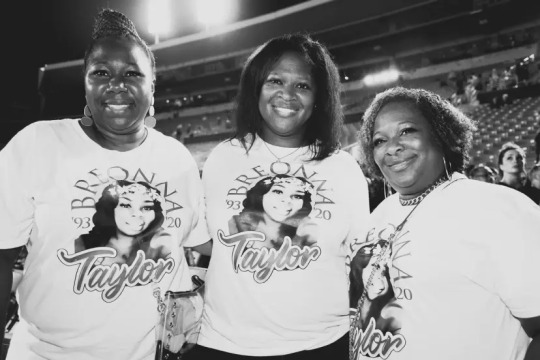
The Renaissance World Tour: Show 26 - L&N Federal Credit Union Stadium - Louisville, Kentucky (7/17/23).
I know Black Parade felt even more special that night, because Breonna Taylor’s (victim of police brutality) family was there. Beyoncé had her fist raised up in the air longer than usual. ✊🏽
#beyoncé#beyonce#beyhive#breonna taylor#justice for breonna#black lives matter#black women matter#black parade#louisville kentucky#renaissance world tour
353 notes
·
View notes
Text
BLACK FEMICIDE AWARENESS
From the Columbia University Mailman School of Pubilc Health; Black women in the U.S. were, on average, six times more likely to be murdered than their white peers for the years 1999 through 2020, according to an analysis of racial disparities in U.S. homicide rates by researchers at Columbia University Irving Medical Center and Columbia Mailman School of Public Health. The study indicates that Black women are more likely than white women to be killed by guns.
In 2020, around 1, 821 black women and girls had their lives taken away from them. Studies show it's mostly done by someone they know such as family members and partners.
Firearms are the main weapon used on the victims. From Connecticut Children's: Firearm violence has driven the homicide rates even further, with three-quarters of homicide victims dying of gunshot wounds. Awareness of this public health crisis has remained low among feminist movements, news media, law enforcement, and community-based organizations.
Intimate Partner Violence Among Young Black Girls and Women: The leading cause for pregnant black women is murder...by their partners. Pregnant Black women are 11 times more likely to be victims of femicide, according to an article published in the journal Obstetrics & Gynecology. Pregnant-associated femicide refers to homicides of women during pregnancy or within one year of pregnancy.
#black girl#black girl blogger#black women#blackgirl#blackwomen#black woman#black feminism#black femininity#black girls of tumblr#misogynoir#black femicide#black women matter#blackwomenmatter#blackgirlsmatter#black girl tumblr#black girls matter
35 notes
·
View notes
Text
PLEASE TAKE THE TIME TO LISTEN AND SHARE THIS STORY 🙏🏾. This is the story of my mother Debrah Daniels who has been held in jail in riverside county since March 2023 for aiding and protecting her grandchild (which is my niece) from two girls that attacked her at her job and even sliced her arm with a pocket knife. Those two women have been walking around free with no repercussions for what they’ve done while my mother has been in jail for 4 months. They are trying to OVERCHARGE my mother with 1st degree attempted murder among other charges and stick her with a life sentence. My mother has been underrepresented by a public defender who did not fight for her during the pre trail and now that we were finally able to provide her with a lawyer her fate is in the hands of the jury now. She has not received ANY support from her family except for me and my older sister, our family has turned their backs on us and has not contributed anything to help, they don’t even ask how’s she’s doing. Our last hope is to rely on the kindness and support from strangers to help spread awareness of my mothers story and put pressure on the courts for their injustice. This is our last hope in bringing my mother home.
If you would like to support and share this story please check out the social media pages we have created and use the hashtag #justice4debrahdaniels. Please follow, like, comment, and share the videos detailing the case to help bring this story to light. Please help us bring my mom home.
Facebook:

Twitter: @justice4debrah
Instagram: justice4debrahdaniels
Tiktok:
#long post#please help#please boost this#boost this#blacklivesmatter#black lives matter#black women matter#black tumblr#black community#share this#injustice#spread this#tiktok#facebook#instagram#twitter#justice4debrahdaniels#california#criminal justice#justice for Debrah#free Debrah daniels#say it til it’s backwards#say her name#please read
366 notes
·
View notes
Text
"Defund the police and who will save you when you're in danger?" Fucker I'll take out an intruder with that huge stick I keep under my bed so I don't fucking get shot for calling the police to help me!
#defund the police#say her name#black lives matter#black women matter#justice for sonya massey#social justice#human rights#systemic racism#anti blackness#i rebuke you in the name of jesus
31 notes
·
View notes
Text
TOPEKA, Kan. (AP) — A white ex-police detective in Kansas died Monday in an apparent suicide just before the start of his criminal trial over allegations that he sexually assaulted Black women and terrorized those who tried fight back.
Local police found Roger Golubski dead of a gunshot wound on the back porch of his split-level home outside Kansas City, Kansas. The Kansas Bureau of Investigation said “there are no indications of foul play” in the 71-year-old’s death, discovered Monday morning after a neighbor heard a gunshot.
Fifty miles (80 kilometers) to the west, prosecutors and Golubski’s attorneys were inside the federal courthouse in Topeka, where Golubski faced six felony counts of violating women’s civil rights. Prosecutors say that, for years, Golubski preyed on female residents in poor neighborhoods, demanding sexual favors and sometimes threatening to harm or jail their relatives if they refused. He had pleaded not guilty.
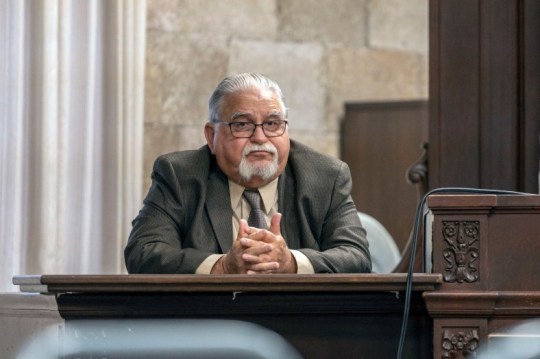
“There is no justice for the victims,” said Anita Randle-Stanley, who went to court to watch jury selection. Randle-Stanley, who is not a victim in this case, said Golubski began harassing her when she was a teenager decades ago, but she always refused him.
The heart of this trial focused on two women: one who said Golubski began sexually abusing her when she was a young teen in middle school, and another who said he began abusing her after her twin sons were arrested. Prosecutors said seven other women were planning to testify that Golubski abused or harassed them as well. And advocates for the women believe there are other victims who have either died or have been afraid to come forward.
The allegations that Golubski preyed on women over decades with seeming impunity outraged the community and deepened its historical distrust of law enforcement. The prosecution followed earlier reports of similar abuse allegations across the country where hundreds of officers have lost their badges after allegations of sexual assaults.
Some of the women and their advocates were upset that Golubski was under house arrest while he underwent kidney dialysis treatments three times a week. Cheryl Pilate, an attorney representing some of the women, said she has questions about how well the government was monitoring Golubski.
“The community had an enormous interest in seeing this trial go forward,” she added. “Now, the victims, the community and justice itself have been cheated.”
Ex-detective described as ‘despondent’ over coverage
After Golubski failed to appear in court Monday, his lead attorney, Christopher Joseph, said his client “was despondent about the media coverage.”
Joseph said he had talked to Golubski regularly, including Monday morning, and he was shocked to hear that his client had apparently killed himself.
As for Golubski’s death, he said, “I don’t know the details.”
This case against Golubski was part of a string of lawsuits and criminal allegations that led the county prosecutor’s office to begin a $1.7 million effort to reexamine cases Golubski worked on during his 35 years on the force.
One double murder case Golubski investigated already has resulted in an exoneration and an organization run by rapper Jay-Z is suing to obtain police records.
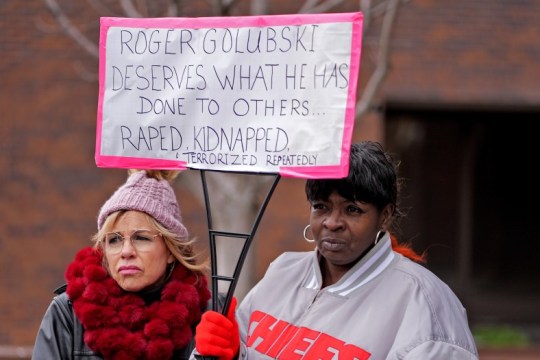
“We have to keep fighting,” said Starr Cooper, who was in the courthouse Monday to watch jury selection and said Golubski victimized her mother before her death in 1983.
Advocates for women rally, lament lack of trial
About 50 people had a short rally Monday morning in sub-freezing temperatures outside the federal courthouse in Topeka to show their support for the women accusing Golubski. They held signs with slogans such as, “Justice Now!”
Lora McDonald, executive director of MORE2, a Kansas City-area social justice group, said participants learned that Golubski didn’t show up in court just as the rally began. They dispersed before prosecutors announced his death.
They later joined Pilate in calling for an independent, outside investigation into Golubski’s death.
“Golubski terrorized an entire community and co-conspired with dangerous people,” McDonald said. “Our rally today was not just about Roger Golubski. Rather, it was about the department in which his criminal activity flourished.”
Pilate lamented that without a trial for Golubski, “In the eyes of the law he died an innocent man.”
Max Seifert, a former Kansas City police officer who graduated from the police academy with Golubski in 1975, said Golubski’s supporters will treat him as a martyred victim of unfair pretrial publicity. He contends the department condoned misconduct.
“I feel that there is always going to be a cloud of mystery about this,” he added.
Decades of whispered allegations
Stories about Golubski remained just whispers in the neighborhoods near Kansas City’s former cattle stockyards partly because of the extreme poverty of a place where crime was abundant and some homes are boarded up. One neighborhood where Golubski worked is part of Kansas’ second-poorest zip code.
Fellow officers once revered Golubski for his ability to clear cases, and he rose to the rank of captain in Kansas City before retiring there in 2010 and then working on a suburban police force for six more years. His former partner served a stint as police chief.
The inquiry into Golubski stems from the case of Lamonte McIntyre, who started writing to McCloskey’s nonprofit nearly two decades ago.
McIntyre was just 17 in 1994 when he was arrested and charged in connection with a double homicide, within hours of the crimes. He had an alibi; no physical evidence linked him to the killings; and an eyewitness believed the killer was an underling of a local drug dealer.
In the other federal criminal case involving Golubski, that drug dealer also was charged with him, accused of running a violent sex trafficking operation.
McIntyre’s mother said in a 2014 affidavit that she wonders whether her refusal to grant regular sexual favors to Golubski prompted him to retaliate against her son.
In 2022, the local government agreed to pay $12.5 million to McIntyre and his mother to settle a lawsuit after a deposition in which Golubski invoked his Fifth Amendment right to remain silent 555 times. The state also paid McIntyre $1.5 million.
#An ex-detective accused of abusing Black women died in an apparent suicide as his trial was starting#Associated Press#Black Lives Matter#white murderers#Black Women Matter#golubski#sex trafficking#MORE2#Topeka KS#kansas
16 notes
·
View notes
Text
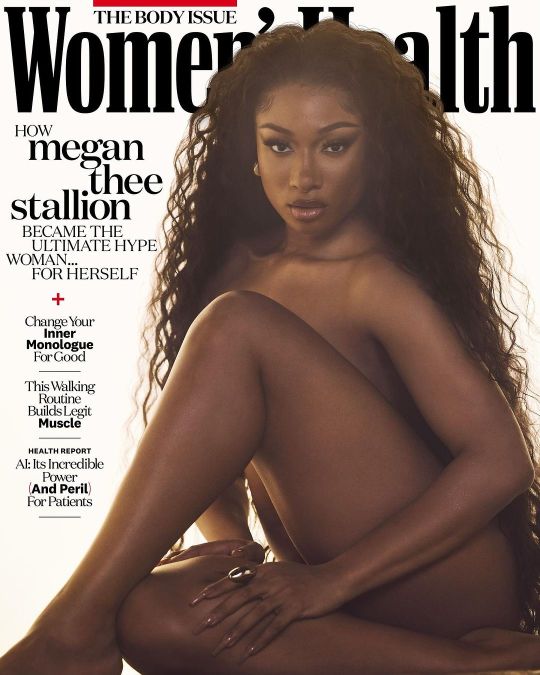


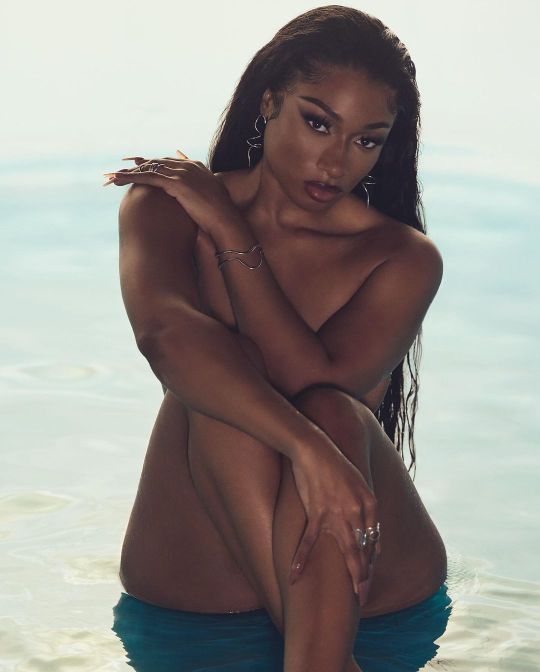



IG: theestallion
Thee Hot Girl Coach for thee cover of Women’s Health Magazine 💙💪🏽
.
.
.
Credits:
Editor-in-chief: lizplosser
Photographer: ramonarosales
Interview: somekindofemme
Stylist: kgsaladino
Hair: kellonderyck
Makeup: lorvida
Manicurist: nailsdid.byginger
Set Designer: carlosanthonylopez of winstonstudios
Design Director: betsyhalsey
Executive Visual Director: fvleroux
Entertainment Director: maxwelllosgar
Production: kindlyproductions
PR Agency: VitalVersatility
Hearst Magazine Entertainment: hmebookings
#megan thee stallion#meg thee stallion#thee stallion#women's health#women's mental health#soft life#soft girl#black girl moodboard#black girl aesthetic#black women moodboard#black women aesthetic#soft black girls#soft black women#black women luxury#black girl luxury#beautiful black girl#black girl beauty#beautiful black women#black women beauty#mental health awareness#black women magic#black women matter#black girl magic#women deserve better
866 notes
·
View notes
Text
Dear Black woman with a long name,
Correct them.
Every. Time.
And make fun of them for mispronouncing it.
13 notes
·
View notes
Text
Be careful and remain mindful of how you react to things and how people react to you. Any black woman responding in anger will frustratingly be deemed "masculine", especially when she's pointing out something unjust as a form of protection. This is because people plan on using us, and by painting us as the aggressor, they'd get away with being victims someway somehow.
I know it's hard to remain calm whenever someone is being aggressive and unjust to you. Still, analyze their emotions and use empathy to your advantage. In truth, when someone is trying to come for you, they're simply projecting onto you in fear of handling their inner demons. When YOU address your own inner demons, however, you'll feel a sense of comfort where the gaslighting will never work on you!
By understanding where people come from, when you have felt like a loser in your down points in life, understand that these people feel just as bad if not worse, projecting onto you as a form of protecting themselves from... themselves I guess. Instead of growing up, they mistreat us! How ludicrous!
Think about how juvenile it is for someone to lose their mind about you as a black woman or girl while you weren't being aggressive, as an example. Notice how idiotic they're being for malfunctioning over your own existence. If you think, "no, I'll never find love and acceptance as a black woman/girl", instead think, "oh, it's only because they're that WEIRD... I don't think I'll need their acceptance since they're a lunatic."
NEVER put anyone on a pedestal for shoving you and forcing you to be at the bottom of their totem pole. Craft your own totem pole and give yourself love and respect to where you needn't rely on brute force and aggression to achieve success. Pettiness can only get your far. Yes, while they KNOW they were petty first, you still don't need to stoop to their level as you will be able to reveal how malintent and ignorant they are by witnessing their immaturity and lack of readiness to mature at the same time. Adopt a princess mentality where you see how immature they are and go about you way in a princess fashion! Don't fight with ignorance, fight with empathy, maturity, and intelligence!
When these people force you to be aggressive because they were aggressive first, know that it's not your fault. Be easy on yourself and love yourself at the same time. Be easy on yourself and heal. The world's ending anyways so you might as well heal and let everyone crumble from their own stupidity lol.
#black women matter#protect black women#misogynoir#black feminism#black femininity#black women#black woman#black women appreciation#black girls rock#black girls of tumblr#🩷.txt
9 notes
·
View notes
Text
Okay, this might be controversial, but …
We all know and see how feminism — mainstream feminism — began to more and more include and revolve around men, although feminism is supposed to be specifically for women‘s rights.
I could say a lot about how mainstream "feminism" has become just another men‘s rights movement in disguise, BUT that‘s not the point of this post.
What came to my mind long ago is that every other social justice movement centers men, too. Now I‘m not saying that men can‘t be oppressed based on ethnicity, sexuality, class, nationality, disability etc., and they certainly are part of movements about these issues. (not comparable to FEMinism, of course, since men are NOT oppressed on the basis of their sex — even intersectional feminism is only for WOMEN as they face unique oppression for being female, and oppressive systems are the result of male supremacy)
However, the more I observe what‘s going on, the more I notice that men are the center of these movements although it affects women just as much, and even more because misogyny and racism, homophobia etc. intertwine.
So, we got an LGBTQIAwhatever+ movement which is more concerned with male sexuality and male feelings than women‘s voices and safety. Not only in terms of the gender debate and the fact that women get dehumanized (e.g. "menstruators", "birthing people", "bonus hole") and that their sex-based reality gets erased, but also when it comes to how LGBTQIAwhatever+ rights are framed. For example, "kink" has been heavily pushed forward by and centered around the men, even during the beginning of the movement, although lesbian and bisexual women have always been critical of it, yet it‘s now the public image we get associated with as well. Women are hoping for solidarity with the men, but the men somehow still don‘t bother to work on their misogyny. It‘s inarguable that while the women and men share the oppression through homophobia — and don’t get me wrong, I think that all LGB people should fight against homophobia together — the women are still oppressed by the men due to misogyny.
We also have a Black Lives Matter movement, which has thankfully raised a lot of awareness since it started and is an integral part of social justice. However, the phenomenon remains the same: Men are centered, whereas the women have to mostly fend for themselves. I‘m not comparing case X to case Z or something like that, but the outrage when a black woman gets violated and faces misogynoir is very little compared to cases of while man on black man violence. I‘m not saying "pay less attention to victims who are black men!", I‘m saying "pay more attention to victims who are black women!" (same goes for racism and hate crimes against other ethnicities). And I‘m not glossing over the fact that there are MANY amazing black women who raise their voices and do meaningful activism, I‘m just saying that they don’t receive the same platform as their male counterparts, face misogyny (including heavy sexualization) from both black and white men and often feel the need to give up some space for the men, as apparently women can‘t talk about the female experience exclusively in the society we live in without getting scrutinized.
Then we got the Disability Rights Movement, which is somehow less popular but still as important. While most of the rights and affirmations are for both men and women alike, the men are still seen as a priority, both compared to other disabled women and in some cases also non-disabled women. Many disabled women have spoken about how disabled men still sexualize them and subject them to their misogyny, and we even got to the point where disabled men are supposed to be given access to rape prostitutes (yes, prostitution is paid rape even when you‘re disabled) whilst disabled women barely have the right to same-sex intimate care and are also more likely to get medically mistreated.
I could go on about how poor/homeless women are belittled and forced into prostitution and therefore overlooked compared to poor/homeless men (the notion that there are more poor/homeless men than women and hence men have it worse is false as the poor/homeless women end up as sex trafficking victims, especially during war times, or at least get coerced into enduring paid rape), how the "body positivity" movement has become another men‘s sexual fantasy, how discussions about religious indoctrination and extremism usually revolve around the boys and men who get dragged into becoming violent fanatics whilst the girls and women are expected to have empathy for their abusers, how men assert their male privilege shamelessly and regardless of all these aspects above …
But in the end, what becomes clear, is that men enthusiastically use the tools of patriarchy even when fighting against other forms of social injustice, and we as women deserve so much better than this — and this is also why we need to unite ourselves and prioritize one another.
#women deserve better#radfem#radblr#radical feminism#feminism#radfems do touch#radfems do interact#radfems please touch#womens rights#sex based rights#social justice#black women matter#lesbians deserve better#disability awareness#anti prostitution#rape culture#male privilege#male violence against women#protect girls#sisterhood
86 notes
·
View notes
Text
I often see people point out intersectional feminism has a huge facet of aknowledging for every 'misandry is real actually' group of minority men people exploit,there's women in that category too they have systemitic privilege over(black men and black women,autistic men and autistic women,trans men and trans women,etc)and i want to add on as a bigender genderfluid black tboy/transfag/sapphillean/[insert other multigender label better than the fb slur here]that this includes men themselves.There's men who're also women and binary transmascs have privilege over us too and they use it to turn our femininity into a target and excuse to make us look like 'bad trans people' or even that we don't exist and are just a stereotype created to degrade 'real' tmascs.That's what the transmed movement was and now they're exploting us too to call lesbians who don't wanna fuck men fascists
@aishabellasbigblogofeverything
#transandrodorks#intersectional feminism#trans#transgender#trans rights#transmasc#transmasculine#tmasc#ftm#trans men#bigender#genderfluid#nonbinary#demigirl#genderqueer#black femme#actuallyautistic#xenogender#lgbt#anti bi lesbian#anti mspec lesbian#lesbophobia#misogynoir#transmisogyny#racialized misogyny#ableism#transfem#black women matter#💌#summerposting
19 notes
·
View notes
Text
As I’ve grown older as a woman, I’ve begun to understand how cheap it is and how dehumanizing it can be, to only be seen or lusted for because of your outer beauty.
When thinking of the opportunities and experiences that were presented and given to me because of the privilege that comes with being very beautiful, I often am hit with the reality that most people who provided such experiences only wanted me to show up as who they wanted me to be. Rather, it was being acquired for love, sexual desires, a void, or to be used; a multitude of them preferred me as their premeditated idea. Ideas that were principally attached to hypersexualization, fantasies, patriarchy, and mainly how I can be used to make their lives more pleasurable. As I come more into this womanhood, I further realize the privilege of beauty is a double-edged sword. I too fell victim to the belief that, as a woman, I am most worthy when I make myself palatable for others to indulge in me. The more I unravel this illusion, the more I've come to know that the best thing I’ve done for myself as a woman is to choose what is most authentic to my femininity and define what that means for me. Much as I do love my outer beauty, there is no comparison—and I mean absolutely no comparison—to the beauty that lies behind my flesh. I also know that not everyone will see it that way, and I’ve begun to truly understand how amazing it is to be deliberately seen and desired for what doesn't just meet the eye. There is something very honorary about knowing that the people who do see me will make space for me the way I make space for myself.
52 notes
·
View notes